Key takeaways:
- Shot framing significantly impacts emotional connection and storytelling by influencing viewer perception and engagement.
- Techniques like the rule of thirds, leading lines, and negative space can enhance visual storytelling and emotional resonance.
- Common mistakes include overusing center framing and neglecting background elements, which can detract from the narrative.
- Personal experimentation with unconventional framing can lead to more compelling narratives and deeper audience connections.
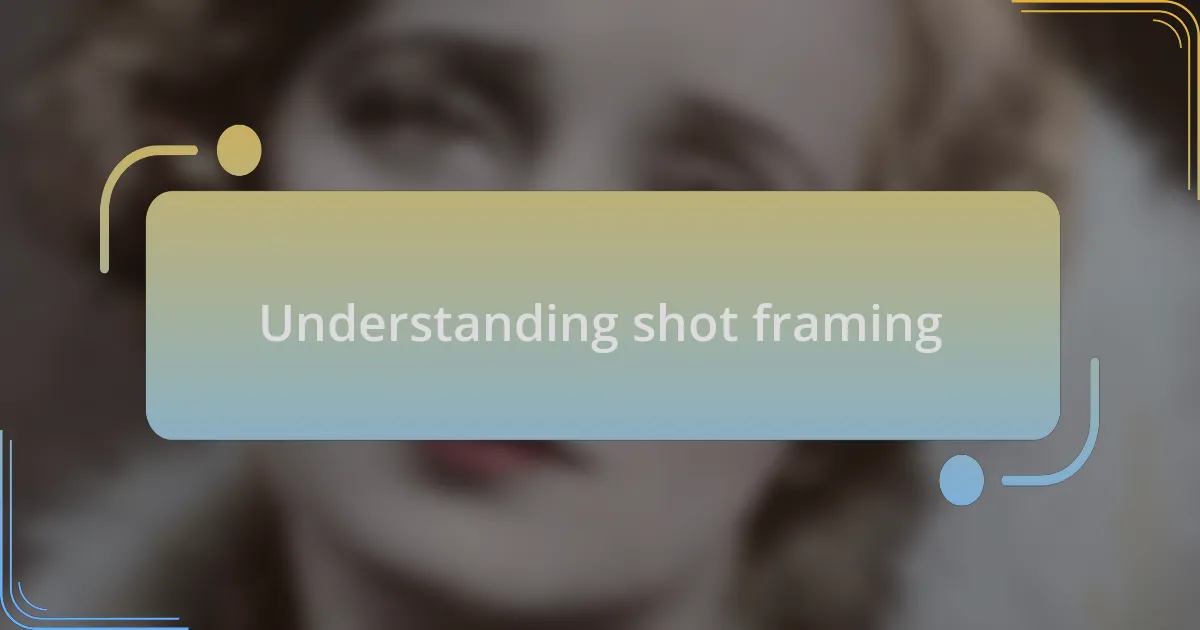
Understanding shot framing
Shot framing is an essential technique that can dramatically influence the viewer’s emotional connection to a scene. I remember a time while shooting a short film when I chose a close-up shot of an actor’s face during a pivotal moment. The shift in their expression, captured in that tight frame, conveyed a depth of sorrow that words simply couldn’t express. Isn’t it fascinating how something as simple as distance from the subject can evoke such strong feelings?
When I first started exploring shot framing, I found myself overwhelmed with options—close-ups, wide shots, and everything in between. It took me a while to realize that each type serves a purpose and tells a story of its own. For example, a wide shot can establish the setting, giving viewers context, while a close-up can draw them into the character’s internal struggle. Have you ever been captivated by a scene because the framing made you feel intertwined with the character’s journey? This creates a connection that lingers long after the film ends.
Understanding shot framing also means considering composition, such as the rule of thirds, which ultimately guides the viewer’s eyes. I often experiment with this rule, positioning subjects at the intersections to create tension or focus. There was a moment when I broke the rule intentionally, placing my subject dead center, and it sparked a different kind of reaction from the audience. It’s a reminder that sometimes, playing with conventions can yield surprisingly powerful results. What have you discovered about framing that transformed your perception of a scene?
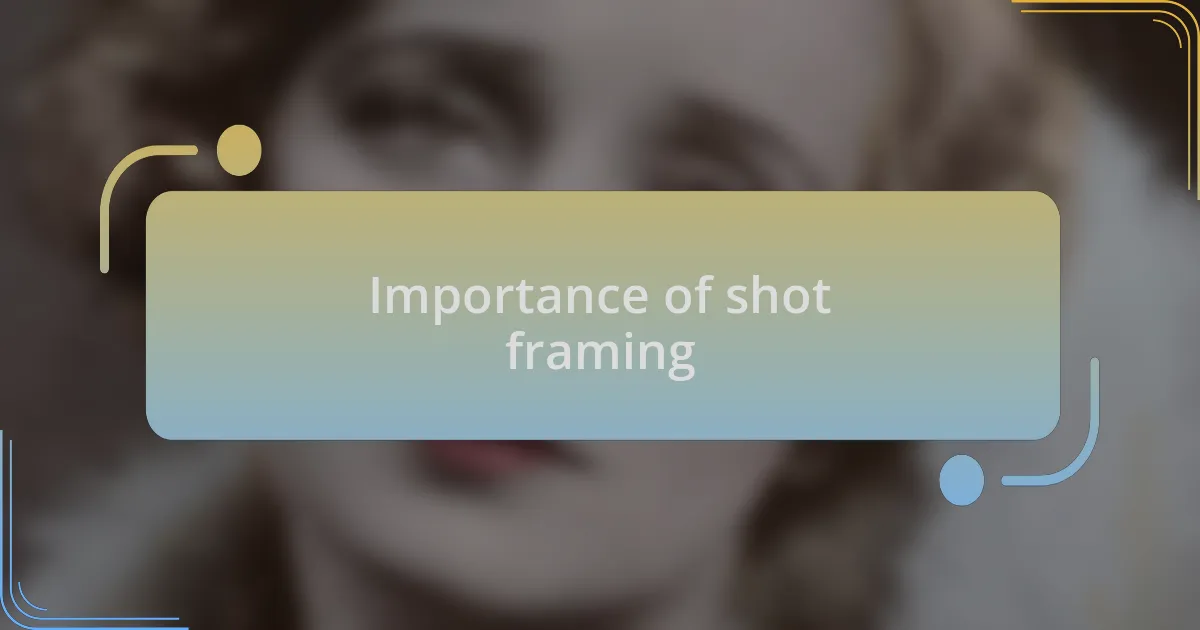
Importance of shot framing
When I think about the importance of shot framing, I often recall a scene from one of my early projects where I used an extreme long shot. It was during sunset, and the framing captured both the character and the expansive horizon, amplifying the feelings of isolation and longing. The wide frame created a sense of space that made the character’s smallness resonate profoundly with the audience, demonstrating how positioning can convey emotional undertones. Have you ever noticed how certain frames can make you feel as if you’re part of the scene, longing alongside the character?
Moreover, shot framing shapes how we interpret the relationships between characters. In a dialogue-heavy scene, I opted for an over-the-shoulder shot during heated exchanges. This simple choice placed the viewer directly in the midst of the conflict, almost as if we were a part of the conversation. It’s interesting how that perspective can alter our understanding of motivations. What do you think happens to the audience’s perception when we see a character framed from a distance versus up close?
Every frame tells a story, and I’ve learned that the nuances in framing can either amplify or undercut the intended emotional impact. During a recent project, I experimented with unconventional angles, which challenged how viewers perceived power dynamics in the scene. By choosing to tilt the camera just slightly, the feeling of imbalance was palpable, pushing the audience to question what they were witnessing. Isn’t it thought-provoking how such subtle tweaks can lead to a completely different viewer experience?
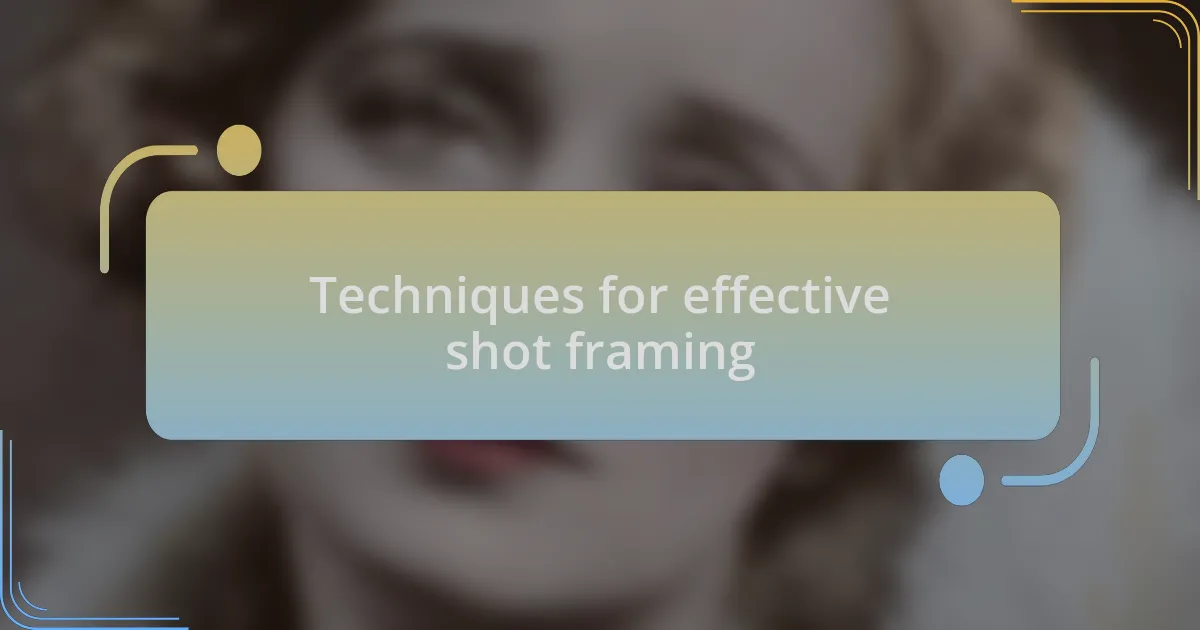
Techniques for effective shot framing
One technique I’ve found transformative is the use of the rule of thirds. By dividing the frame into a grid of nine parts and placing key elements along these lines or at their intersections, I’ve seen how it naturally draws the viewer’s eye. I remember framing a scene where I positioned a character’s gaze at the intersection, which created an immediate emotional connection. Have you noticed how something as simple as grid alignment can elevate visual storytelling?
Another effective approach is the use of leading lines to guide the viewer’s attention. While working on a documentary, I captured footage of a winding path that led toward my subject. This choice not only emphasized the journey but also created a sense of anticipation. I often find myself wondering how viewers react when they’re subtly led into a scene; can they feel the momentum building along those lines too?
Lastly, incorporating negative space has been a game-changer in my work. By intentionally leaving a portion of the frame empty, I can amplify the emotions of the subject. In one short film, I left a vast area of sky above a solitary figure, enhancing feelings of loneliness. It really makes me consider how silence and stillness in a frame can evoke strong emotions—what do you think viewers sense when they encounter that kind of quiet in imagery?
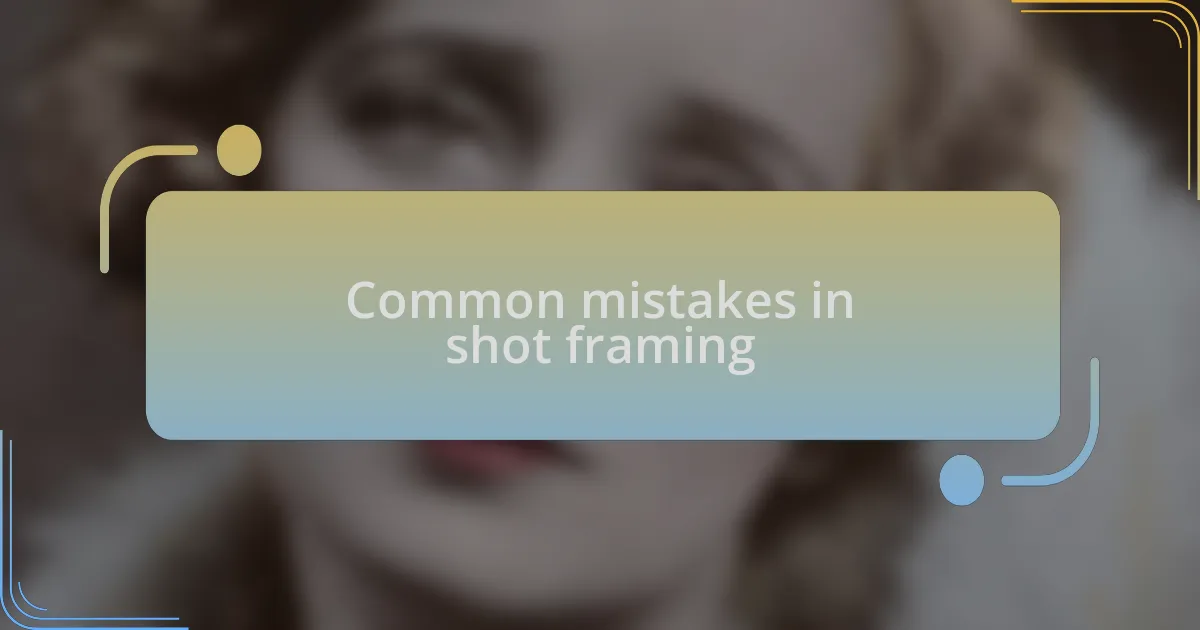
Common mistakes in shot framing
One common mistake I often see in shot framing is the overuse of the center of the frame. While it might seem like a straightforward choice, it frequently leads to static and unengaging visuals. I remember filming a scene where I instinctively centered the protagonist, but it felt flat. It made me realize: how often have we overlooked the dynamic power of off-center placements?
Another pitfall is ignoring the background elements in a shot. During a project I worked on, I was so focused on my main subject that I completely missed the clutter in the background, resulting in distracting elements that detracted from the narrative. I’ve learned that every element in the frame tells a part of the story; what distractions can silently undermine a powerful performance?
Finally, many filmmakers underestimate the impact of framing subjects too tightly. I recall a moment when I closely framed a character’s face during a key emotional reveal, but I later realized that the surrounding environment could have enhanced that moment. It’s interesting to consider how a little breathing room can often add context and depth; have you ever noticed how wider frames can invite viewers into a scene?
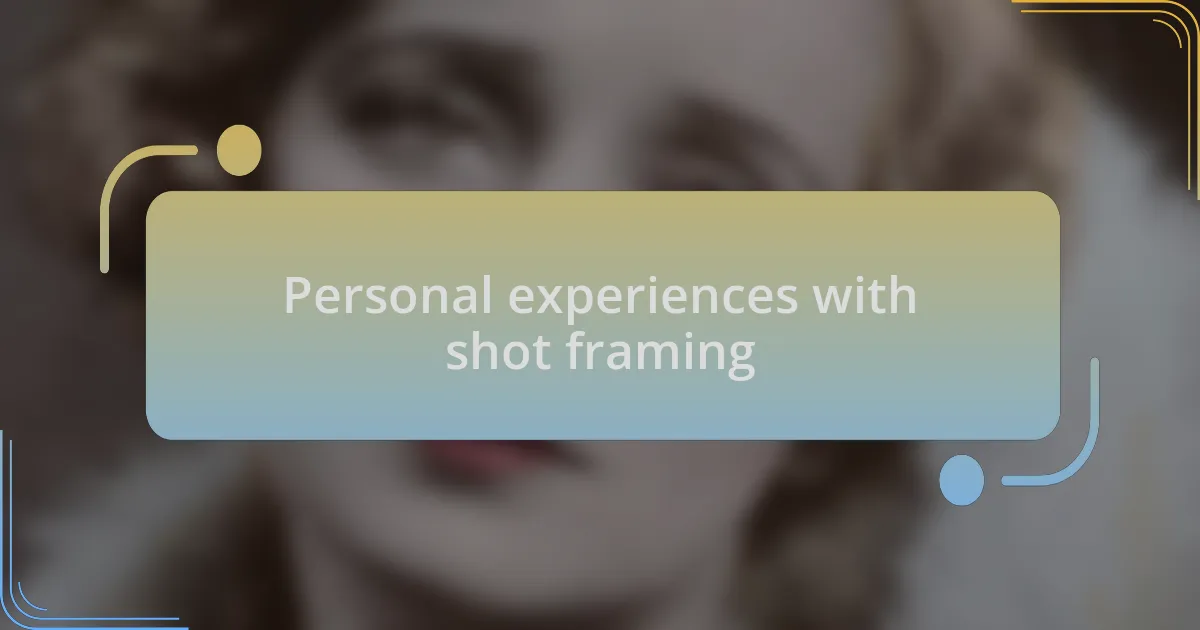
Personal experiences with shot framing
When I think back to my early days of shooting, I remember the thrill of exploring the rule of thirds. In one particular scene, I deliberately placed a character at an intersection of the lines while incorporating leading lines that drew the viewer’s eye to them. The result was striking—it felt like the composition had its own heartbeat. Have you ever felt that rush when a shot just works?
There was another time I experimented with framing by isolating a subject using negative space. I shot a lonely figure against a vast, empty landscape, and the emotional weight was palpable. It struck me how powerful the absence of elements can be; sometimes less really is more. Have you ever tried to let the emptiness amplify the subject’s feelings?
In a recent project, I took a risk by framing a conversation between two characters with an unconventional angle. I was nervous, fearing it might confuse the viewers, but the result was stunning. It added a layer of intimacy and tension that made the moment more compelling. It’s fascinating how a shift in perspective can transform a narrative; have you ever dared to change your viewpoint in your shots?
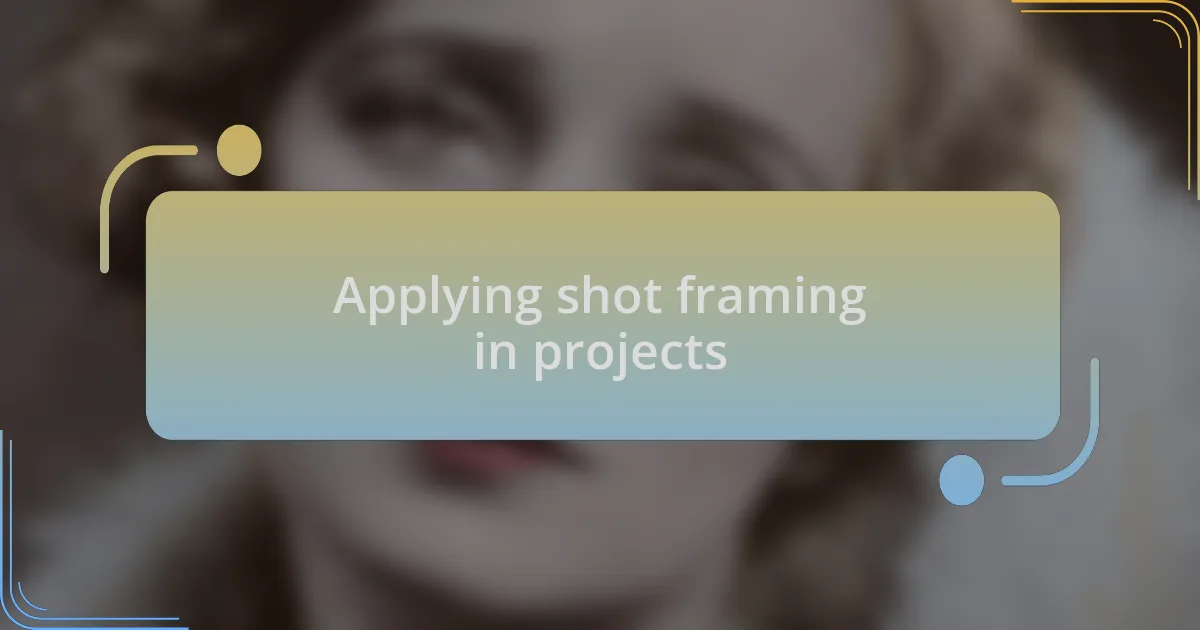
Applying shot framing in projects
When applying shot framing in my projects, I’ve discovered the importance of framing for storytelling. In one instance, I captured a character standing at a crossroads, balanced perfectly between the foreground and background elements. This setup not only visually represented their inner conflict but also pulled the audience into their dilemma. Have you ever noticed how framing can elevate the emotional stakes of a scene?
Another lesson I’ve embraced is the use of symmetry in my shots. During a promotional video for a local business, I positioned the product centrally with matching elements on either side, creating a harmonious view. The feedback from the client was immediate; they felt it showcased their brand’s professionalism. Isn’t it remarkable how a simple decision in framing can impact the viewer’s perception and message?
In my latest documentary project, I experimented with unconventional shots by incorporating extreme close-ups to convey urgency. By framing the subject’s intense expressions, I was able to capture raw emotions that resonated deeply with the audience. This approach led me to reflect on how sometimes, a tight shot can speak louder than a wide shot; have you found moments where intimacy in framing transformed your storytelling?